December Auction Report
Auctions in December are always a little elegiac in feel — it’s the end of the year, the days have gotten shorter, and nighttime comes quickly making the whole idea of exuberant celebration of luxury and exultation over astonishing results (assuming there are any) seem a little foreign to the spirit of the season. That said, there were, at the very least, some interesting watches and some interesting results. While I don’t think there was anything that anyone would call a shock, there were, at least for some lots, pleasant surprises.
Christie’s led the charge with its Important Watches auction on Dec. 8, which was perhaps at a slight disadvantage thanks to the fact that it was the first major auction of the week. There’s a possibility that at least some folks might have been keeping their powder dry for Sotheby’s and Phillips, which followed later in the week. Coming off November Auction Week, almost anything short of another set of records was probably going to seem a little anticlimactic — Christie’s star lots were from the collection of former Ferrari F1 boss Jean Todt, the sale of which made Christie’s the leader for that week, with CHF 55.5 million in sales.
By contrast, the New York Important Watches sale was relatively modest, with sales totaling $6,768,720, but the catalog was also obviously not intended to have the star power of November. The top lot from Patek Philippe was, unsurprisingly, a 5711/1A-014 Nautilus with a green “victory lap” dial which went for $352,800, eclipsing an extremely beautiful rose gold Patek from 1950, with a cloisonné enamel dial, which sold for $252,000 on a high estimate of $400,000.
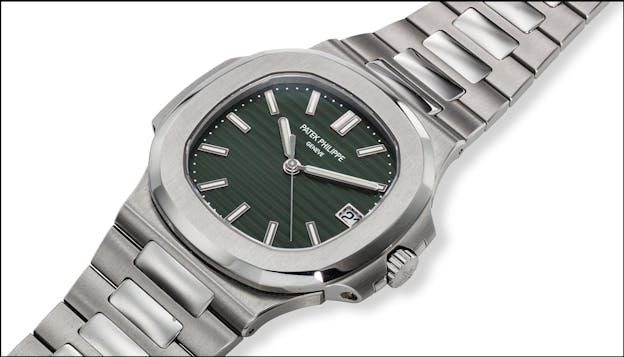
I was slightly surprised by the number of lots that did not sell, although given the time of year and the sheer level of activity only last month, maybe I shouldn’t have been. By and large, the unsold lots — over 20 out of 117 — seem to have been somewhat niche in appeal; it’s probably not terribly shocking that a couple of skeletonized Audemars Piguet watches from the 1980s (gold on gold), which are rather delicate-looking and require a potential bidder to have very evolved and very specific taste, didn’t sell. Nor a Cartier double mystery tourbillon from the mid-2000s, which, for all I liked the Fine Watchmaking Collection, is a bit of a poster child for what it turned out the market did not want from Cartier (at least, not in the numbers they were produced).
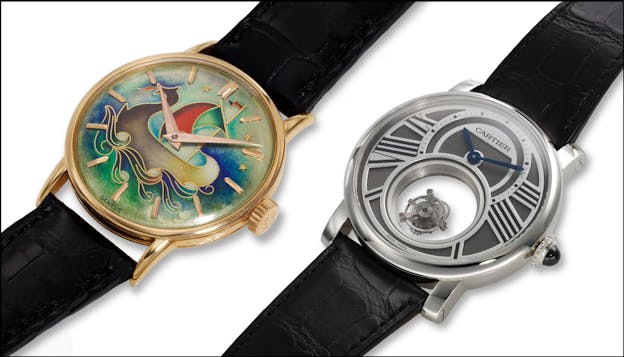
Sotheby’s Important Watches auction, which followed Christie’s on Dec. 9, had a total of 128 lots, with a wide range of unusual pieces, including two Jaeger-LeCoultre Gyrotourbillons (which were the best thing since sliced bread to collectors when first introduced, although they seem to puzzle some newer enthusiasts — like the Cartier double mystery tourbillon, they are a bit the product of a particular era) and several beautiful enamel dial watches.
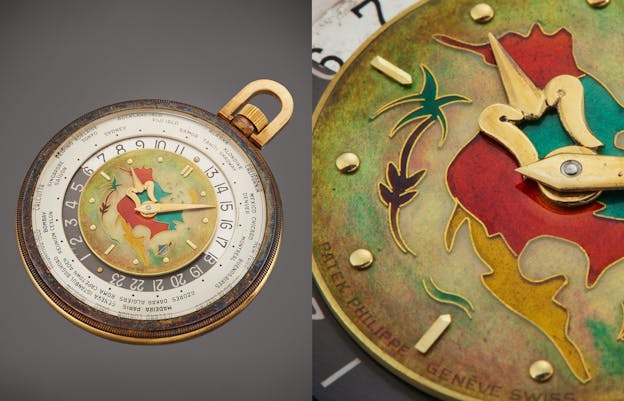
One of these was a pocket watch — a Patek ref. 605 world timer, with cloisonné dial from 1948, which sold for $765,000 on a high estimate of $1,000,000. A Patek pocket five-minute repeater from 1903, retailed by Tiffany, went for $25,200 on a high estimate of $9,000 and was still, if you ask me, one of the great bargains of the week in terms of horological bang for the buck.
Speaking of Cartier, Tanks are apparently not yet tanking — a Paris Crash from about 1991 sold for $226,800 on a high estimate of $180,000 (in May of this year, Loupe This sold one for $304,700).
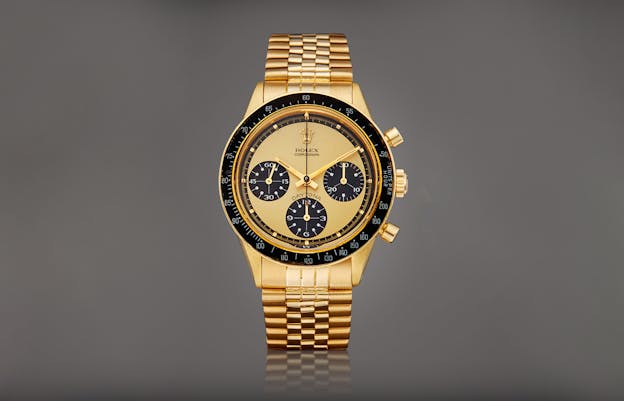
The general, the trend at the high end seemed to be for watches to sell under high estimates; lot 50, a 6264 “Paul Newman Lemon” Daytona sold for $819,000; a Patek 5016P repeater and perpetual calendar with retrograde date went for $639,000 on a million dollar high estimate as well. One surprising result was for, of all things, a platinum Audemars Piguet Jules Audemars Grande Sonnerie, which sold for $239,000 on a high estimate of $80,000.
Phillips was last on the calendar but certainly not least — the top lot in The New York Watch Auction: SEVEN was a very early F. P. Journe Tourbillon Souverain, number 38, which, thanks to its rarity, historical importance and unusual pink gold dial, sold for $1,240,000 on a high estimate of $600,000, followed by a Daniels Anniversary which sold for $816,000. Of the 16 F. P. Journe lots, 12 sold for more than their high estimates, including the first lot, an Élégante, which went for $52,920 on its $20,000 high estimate. On the other hand, an original owner London Crash from 1970, went for $453,000, below its $800,000 high estimate.
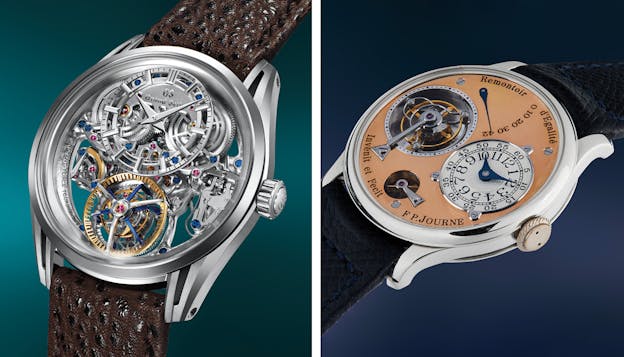
Grand Seiko was a major presence in the auction, reflecting the continued growing strength of collector interest in GS and the one-off Kodo constant force tourbillon sold for $478,000 — the watch was actually consigned by Grand Seiko, and the winning bidder was offered a trip to Japan to meet the team that created it; the sale benefited, in part, the Children’s Heart Foundation. Phillips had a “chapter,” as they put it, of ten Grand Seiko lots which went, by and large, for respectable if not necessarily astonishing prices, including an SBGZ001 hand-hammered platinum-cased Spring Drive, which went for $81,900 on a high estimate of $80,000.
One closely watched lot was from URWERK – a unique piece, UR-102.02, sold to benefit Swiss Institute, a gallery in downtown Manhattan “dedicated to promoting forward-thinking and experimental art.” The design is a throwback to the original UR-101, launched at Baselworld in 1999, with a twist — the dial is coated with temperature-sensitive pigments, changing color as with the ambient temperature. The watch was designed in collaboration with artist Cooper Jacoby. The auction notes said this will be the first watch of the “coming UR-102 reloaded collection” and, on a high estimate of $80,000, sold for $403,200.
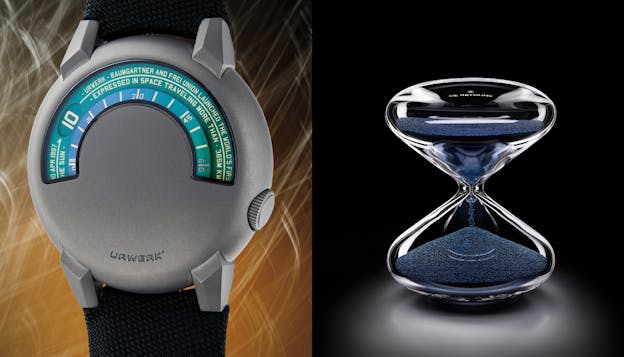
If there was one consistent through-line, it was one seen already in November — the heat is off so-called hype watches to some extent, and quality, rarity and provenance still trump a softening in the market. Being an independent brand with solid horological credentials doesn’t hurt either — three De Bethune lots at Phillips all performed above high estimates (including an HG Timepiece X De Bethune hour glass, which sold for $44,100 on a high estimate of $24,000 — I don’t know about you but it seems to me figuring out a realistic estimate for an hourglass has to be one of the more interesting problems you can have if you’re an auction house) and a M.A.D. edition from MB&F, also sold to benefit the Swiss Institute and formerly owned by Eric Giroud, went for $11,970 on a $2,000 estimate.
The overall impression I came away with was that the correction in market prices may reflect a welcome return to some semblance of normalcy in many instances and for a number of benchmark references, but it in no way represents a loss of interest, and in 2023 could definitely lead to more watches being on wrists rather than in headlines — a good thing for everyone except for the more aggressive flippers and speculators, who were never really here for the watches anyway.

